
Parks need funding for maintenance goal
What do a storm-withered building, a broken bridge, a mangled visitor center and an outdated water facility have in common?
They each contribute to an estimated $8 billion deferred maintenance problem, which grows by $800 million each year.
As part of his 2000 election platform, President Bush promised to balance the backlog, which was $5 billion at the time. Now, with less than two years left in office, Bush has recently announced a new plan known as the Centennial Initiative to tackle operational and maintenance problems in national parks.
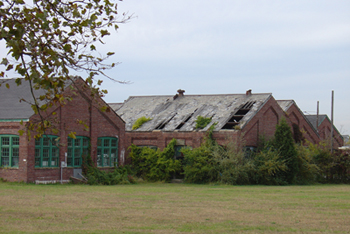 |
Crumbling buildings at Gateway National Recreation Area. Because of funding shortfalls, parks struggle to maintain historic buildings (Photo courtesy of Alexander Brash, National Parks Conservation Association). |
The Centennial Initiative proposes $3 billion to be invested in the United States’ 390 national parks over the next 10 years. Also, there are three components of the initiative that will be allocated towards the national parks annually: $100 million in private donations, $100 million in federal funding to match the private sector and $100 million appropriated by the president as part of his budget plan.
Kurt Repanshek, a freelance writer who focuses on national park issues and author of National Parks with Kids, is doubtful that the initiative will address the backlog problem. In a phone interview, Repanshek said a shortcoming of the plan is support from charity.
“Once you start relying more on private dollars, you’re going to keep relying on it down the road,” Repanshek said.
Michael Jester, park facility manager at the Everglades National Park in South Florida, feels that the Centennial Initiative is too optimistic because so much work has to be completed before 2016.
Storm damage to Mount Rainier National Park in Washington. Managers estimate that repairs exceed $30 million (Photo courtesy of Mount Rainier National Park). |
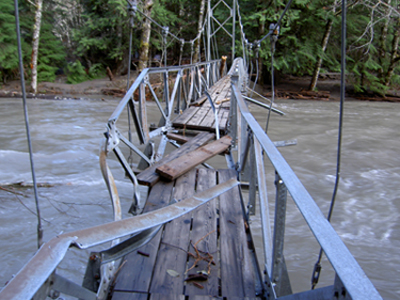 |
“When you’re strapped for resources, the question is ‘who is going to support an increase in project workload’,” Jester said. “We’re barely able to execute the work we have now.”
The Centennial Initiative has not been approved by Congress, but if it is approved, Bush’s successors will have to continue allocating $100 million yearly to keep up with the third component of the plan.
Apart from the Centennial Initiative, the Bush Administration has approved more than $5 billion for national parks since taking office, but is this money solving the deferred maintenance problem?
Randy Ross, facility manager at Apostle Islands National Lakeshore on Lake Superior in Wisconsin, said that his park has received the most funding in years, yet more money is needed to deal with the consistent maintenance backlog.
“We have a constant problem with dock maintenance due to usage and movement of ice in the winter,” Ross said. “We also deal with trail maintenance and upgrading campsites regularly. Even when one project ends, there’s a new one that needs to be tackled.”
Ross also mentioned that parks such as Apostle Islands are suffering from a lack of full-time employees.
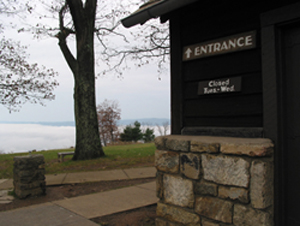 |
Closed Visitor Center at Shenandoah National Park in Virginia. Parks struggle to keep visitor facilities open without adequate funding and staff (Photo courtesy of Erin Haddix, National Parks Conservation Association). |
“They’re throwing a lot of money at us, but we don’t have enough core workers to use the money to fix things.”
Although the Bush Administration has increased the national parks budget, National Park Service Public Affairs Officer Jeff Olson, who is based in Washington, D.C., said that this affects some parks more than others.
Olson noted that 50 percent of the money allotted for national parks is concentrated on only eight parks, which includes Yellowstone, Yosemite, Grand Canyon and The Great Smoky Mountains National Park.
Even with the extra money, these parks also suffer from cyclic maintenance backlog problems.
“A lot of times the things that are donated to us are worn out, and the cost of fixing them up is far greater than new construction,” Olson said. “Sometimes materials on old buildings might be different sizes than they are today.”
With a war in Iraq, a growing federal budget deficit and various other problems that affect U.S. citizens, Blake Selzer, legislative director of the Washington D.C.-based National Parks Conservation Association, an organization devoted to protecting and enhancing America’s national parks, still hopes voters push for additional money to fund national park projects.
“If you don’t deal with the maintenance backlog problem, maintenance facilities will start to crumble and we will lose cultural and historical resources forever,” Selzer said. “Since it’s a multi-billion dollar problem, it’s going to take a multi-billion dollar effort.”
Everglades boardwalk wear and tear (Photo courtesy of the National Park Service). |
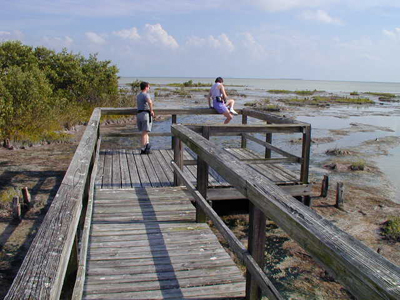 |
Currently, the money budgeted for national parks for fiscal year 2007 is $2.6 billion. Selzer said that the NPCA is calling for an additional $800 million added to the fiscal budget to keep up with the maintenance backlog that continues to grow every year.
With a problem as large as the maintenance backlog, national park representatives feel there is not a single initiative or budget change that will cure the problem.
Rick Smith, a member of the executive consul of the Coalition of National Parks Retirees has worked at Yellowstone, Yosemite and the Grand Canyon. He said that only a combination of factors working together can truly solve the problem by 2016.
“It’s going to require a commitment at the federal level to appropriate the amount of money needed and it’s going to require a commitment on the part of the American people to encourage its Congressional delegations to support those appropriations,” Smith said. “Also it’s going to require a commitment from the public sector to provide the support in places where the federal government can’t do the work.”
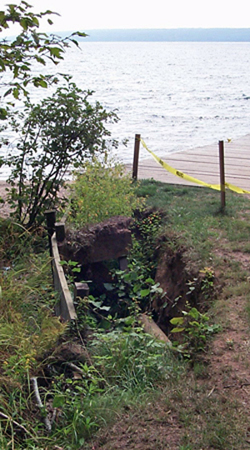 |
Erosion next to Oak Island Dock at Apostle Island National Lakeshore. The park uses visitor donations to improve facilities and reduce the maintenance backlog (Photo courtesy of the National Park Service). |

Comments are Closed